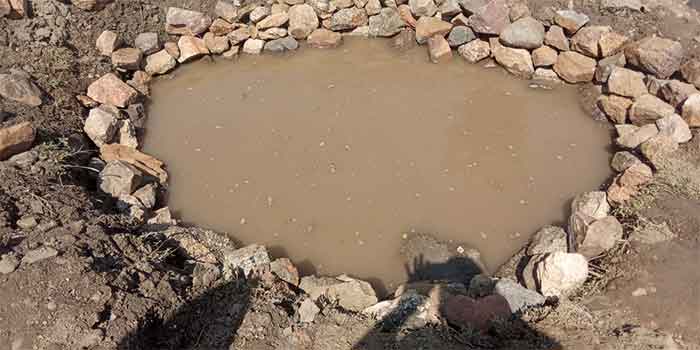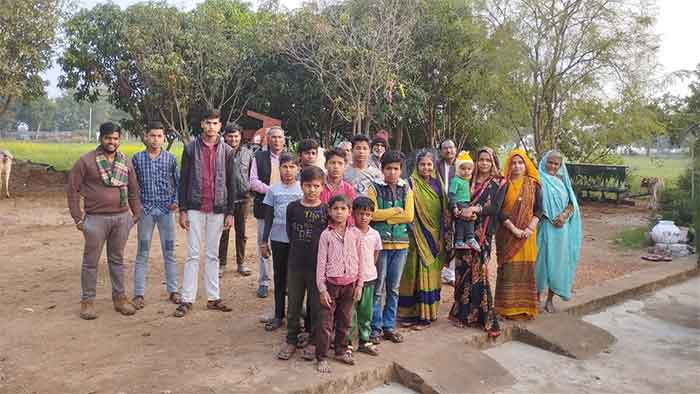
As India is troubled increasingly by more scorching heat waves than ever before, its water worries are also increasing. With 18% of the world’s population and 15% of its livestock but only 4% of the its fresh water resources, India is a water-stressed country whose water woes are further increasing in the times of climate change with more frequent droughts, erratic weather and intense heat waves. A past history of over-exploiting groundwater has added further to these worries—among the 6,965 units for assessing groundwater, 1114 are already categorized to be over-exploited while 1327 are classified as critical or semi-critical. 97 are saline.
However an important ray of hope still exists in the form of a significant number of small-scale water harvesting and conservation projects some of which have shown very encouraging results. These include efforts made by several voluntary organizations as well as the government.
In Chitrakut district ( UP) the Patha area inhabited largely by Kol tribal communities has been often in news due to water scarcity. However the water harvesting structures taken up by a voluntary organization the ABSSS have contributed much to bringing considerable relief in villages like Tikariya, Mangava and Itwa Patan. Many more farms can now get irrigation. Farm animals as well as wild animals have much better access to water. Drinking water wells get recharged by the harvested water. Pastures have more grass. A hamlet which was abandoned due to very adverse conditions, Gursarai, was resettled and re-cultivated once water became available.
Gaya Prasad Gopal, a senior social activist who has seen all these changes says, “The first stage of our work involved helping the tribal communities to get land rights. Soon after this when several of them got water as well, this helped them to get sustainable livelihoods while earlier they had to toil almost in conditions of bonded labor for very low wages.”
This also ensured that there was very close community involvement in the water harvesting work. Parvati, a peasant woman who took keen interest in the project said, “Committees of villagers were formed and most decisions were taken by these committees on the basis of local conditions.”
This also helped to reduce costs significantly. Most of the work was in the form of ponds, check dams and related structures, taken up at a cost of just half a million Rs. each. The Tikuri-Purva check dam in Kekramar village, for example, was constructed with just Rs. 3 lakh ( 10 lakh=1 million) but managed, at its peak, to irrigate about 40 hectares of farmland, as estimated by Gopal on the basis of records. The benefits in terms of recharging of wells are wider.
The ABSSS has received important support in this work from important government agencies including NABARD, as well as from leading development organizations like Action Aid and Oxfam. The work of the ABSSS is based in Bundelkhand region, a region spread over 13 districts of Central India which has been much in news due to water scarcity.
In sharp contrast to such low-cost, high benefit projects, unfortunately a lot of funds are being wasted here in gigantic projects of dubious merit. Such a highly expensive water transfer project called Ken-Betwa Link is being taken up here at the cost of Rs. 45,000 crore ( one crore=10 million). Its benefits have been contested by several independent experts. It involves the felling of over 2 million trees and displacement of thousands of people.
On the other hand the small water harvesting projects do not generally have such harmful side-effects and their benefits are much more certain and reach people within a year or two. At the rate of even a million Rs. as an average budget for one such project, 450,000 such water harvesting projects can be financed from the budget of the Ken-Betwa Link Project. Hence there is a strong case for giving much higher priority to small, decentralized water harvesting and conservation projects implemented with the help of local communities.
In Rajasthan state a voluntary organization called the Barefoot College has achieved great success by following precisely this approach and encouraging villagers to contribute with their traditional wisdom of water conservation and rainwater harvesting. Good quality of drinking water has been confirmed by frequent testing in its water harvesting structures. In several schools these structures have helped to quench the thirst of students and and kept the schools going during difficult times of water scarcity.
In some villagers located close to Sambhar Salt Water Lake brackishness of water has been increasing. The challenge was to check this while creating alternative sources of better quality freshwater. Utilizing a grant received from an UK based organization Belu Water, freshwater available at a hill top in some water sources was harvested for Korsina and nearby villages. Catchments were improved by bunds and improving greenery so that more rainwater could be available. The capacity to recharge was improved by more bunds in lower areas. The result was that people and animals started getting more and better quality water. The existing water sources in this as well as some neighboring villages were also recharged. More and better water was available in wells, hand pumps and ponds.
This success was possible on the basis of the close cooperation of the Barefoot college, local organization Prayatna and the village community. As conversations with elderly villagers like Sonath Gujar revealed, they had very good understanding of water conservation and their rich knowledge of local conditions contributed much to the success of the project. In fact this farmer from Korsina took my notebook and pen to draw for me a detailed diagram explaining how this project can expand in future to benefit more villagers. Ramkaran, a social activist with the Barefoot College who has been closely involved in all stages of this work says, village committees are entrusted with fund management and related responsibilities in conditions of complete transparency. Hence conditions of trust and honesty are created in which the best participation of people can be secured, while in the absence of such trust and cooperation such good results cannot be achieved.
Water access in some of the most water scarce villages led by Korsina could be completed just on the basis of a project costing Rs. 18 Lakh, out of which Rs. 10 lakh was spent on wages of workers belonging to poorest households in the same villages. This is the kind of great utilization of funds which has been possible in some of the best planned water harvesting projects.
Some other projects along similar lines, also achieving equal success, have been taken up in other villages of Rajasthan by the Barefoot College in cooperation with other organizations. These include projects in Palona and Mandavariya villages in Ajmer district.
While all these projects in water scarce areas of Rajasthan and Bundelkhand have brought significant relief at a low budget, at the same time those involved in their implementation all agree that with increasing droughts and heat waves, much more such work has to be taken up now. Hence there is a clear need to use the limited water budgets more judiciously and wisely so that more resources are available for such low cost, high benefit, small-scale projects instead of committing most funds to extremely costly projects with serious adverse side-effects.
Bharat Dogra is Honorary Convener, Campaign to Save Earth Now. His recent books include A Day in 2071, Man over Machine and India’s Quest for Sustainable Farming and Healthy Food.













































